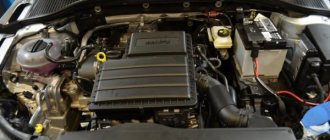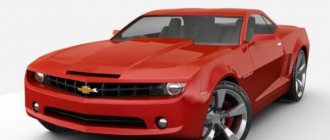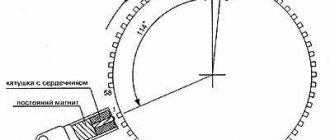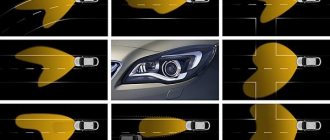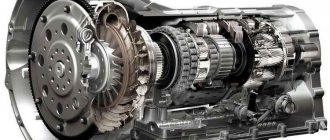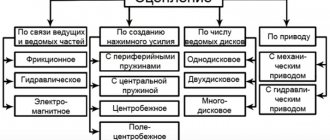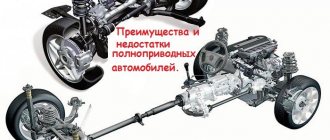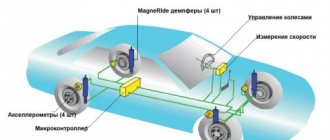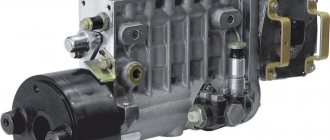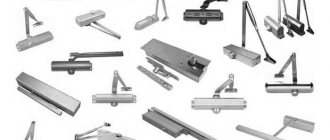Multiport or multipoint fuel injection
Let's start with him, all because he appeared first (before his opponent). Prototypes existed at the dawn of the 20th century, although they were far from ideal and often used mechanical control.
Abbreviation MPI (Multi Point Injection) - multi-point distributed injection. In essence, this is a modern injector
Now, with the development of electronics, the carburetor and other power systems that were present at the dawn are becoming a thing of the past. Distributed injection is an electronic power system that is based on injectors (from the word injection), a fuel rail (where they are installed), and an electronic pump (which is mounted in the tank).
It’s simple, the ECU orders the pump to pump fuel, it goes along the line to the fuel rail, then into the injector and then is sprayed at the level of the intake manifold.
But this system has also been refined over the years. There are three types of injection:
- Simultaneous . Previously, in the 70s and 80s, no one cared about the price of gasoline (it was cheap), and no one thought about the environment. Therefore, fuel was injected into all cylinders at once, with one revolution of the crankshaft. This was extremely impractical, because as usual (in a 4-cylinder engine) two pistons work on compression, and the other two remove exhaust gases. And if you supply gasoline to all the “pots” at once, the other two will simply throw it into the muffler. Extremely expensive in terms of gasoline and very harmful to the environment.
- Pair-parallel . This type of distributor injection, as you probably already guessed, occurred in two cylinders in turn. That is, the fuel entered exactly where compression is now taking place.
- Phased type . This is the most advanced method at the moment, here each nozzle lives “its own life” and is controlled separately. It supplies gasoline just before the intake stroke. Here there is maximum economy of the mixture, as well as a high environmental component
I think this is clear, it is the third type that is now installed on all modern car models.
WHERE IS THE INJECTOR LOCATED ? Here lies the main difference between distributor injection and direct injection. The injector is located at the level of the intake manifold, next to the engine block.
The mixing of air and gasoline occurs in the manifold. Dosed air comes from the throttle valve (which you regulate with the gas pedal), when it reaches the injector, fuel is injected, resulting in a mixture that is already drawn through the intake valves into the engine cylinders (further compression, ignition and exhaust gas removal).
The ADVANTAGES of this method include the relative simplicity of the design, low cost, and the injectors themselves should not be complex and resistant to high temperatures (because they do not have contact with the combustible mixture), they work longer without cleaning, and are not so demanding on the quality of the fuel.
DISADVANTAGES higher fuel consumption (compared to the opponent), less power
BUT, due to their simplicity, cheapness and unpretentiousness, they are installed on a large number of engines not only in the budget segment, but also in the D-class.
Types of injection systems for gasoline engines
There are several main types of fuel injection systems, which differ in the way the air-fuel mixture is formed.
Read more: Japanese car auctions - descriptions and rules of operation
Scheme of operation of the mono-injection system
The central injection scheme provides for one injector, which is located in the intake manifold. Such injection systems can only be found on older passenger cars. It consists of the following elements:
- Pressure regulator - provides a constant operating pressure of 0.1 MPa and prevents the appearance of air locks in the fuel system.
- Injection nozzle - pulses gasoline into the engine intake manifold.
- Throttle valve - regulates the volume of supplied air. May have a mechanical or electric drive.
- Control unit - consists of a microprocessor and a memory unit, which contains reference data for fuel injection characteristics.
- Sensors for engine crankshaft position, throttle position, temperature, etc.
Gasoline injection systems with one injector operate according to the following scheme:
- The engine is running.
- Sensors read and transmit information about the state of the system to the control unit.
- The obtained data is compared with the reference characteristic, and, based on this information, the control unit calculates the moment and duration of opening the nozzle.
- A signal is sent to the electromagnetic coil to open the injector, which leads to the supply of fuel to the intake manifold, where it is mixed with air.
- A mixture of fuel and air is supplied to the cylinders.
A distributed injection system consists of similar elements, but in this design there are separate injectors for each cylinder, which can open simultaneously, in pairs or one at a time. Mixing of air and gasoline also occurs in the intake manifold, but, unlike single injection, fuel is supplied only to the intake tracts of the corresponding cylinders.
Diagram of operation of a system with distributed injection
The control is carried out electronically (KE-Jetronic, L-Jetronic). These are universal Bosch fuel injection systems that are widely used.
Operating principle of distributed injection:
- Air is supplied to the engine.
- Using a number of sensors, the volume of air, its temperature, the speed of rotation of the crankshaft, as well as the throttle position parameters are determined.
- Based on the data received, the electronic control unit determines the volume of fuel that is optimal for the amount of air supplied.
- A signal is given and the corresponding injectors open for the required period of time.
The system provides for the supply of gasoline through separate injectors directly into the combustion chambers of each cylinder under high pressure, where air is simultaneously supplied. This injection system provides the most accurate concentration of the air-fuel mixture, regardless of engine operating mode. In this case, the mixture burns almost completely, thereby reducing the volume of harmful emissions into the atmosphere.
Direct injection system operating diagram
This injection system has a complex design and is sensitive to fuel quality, which makes it expensive to manufacture and operate. Since the injectors operate in more aggressive conditions, for the correct operation of such a system it is necessary to ensure high fuel pressure, which must be at least 5 MPa.
Read more: Pilots antifreeze review: types, reviews, features, photos and videos
Structurally, the direct injection system includes:
- High pressure fuel pump.
- Fuel pressure control.
- Fuel rail.
- Safety valve (installed on the fuel rail to protect system elements from pressure increases above the permissible level).
- High pressure sensor.
- Injectors.
An electronic injection system of this type from Bosch is called MED-Motronic. The principle of its operation depends on the type of mixture formation:
- Layer-by-layer - implemented at low and medium engine speeds. Air is supplied to the combustion chamber at high speed. Fuel is injected towards the spark plug and, mixing with air along the way, ignites.
- Stoichiometric. When you press the gas pedal, the throttle valve opens and fuel is injected simultaneously with the air supply, after which the mixture ignites and burns completely.
- Homogeneous. Intensive air movement is provoked in the cylinders, while gasoline is injected during the intake stroke.
Direct fuel injection in a gasoline engine is the most promising direction in the evolution of injection systems. It was first implemented in 1996 on Mitsubishi Galant passenger cars, and today most major automakers install it on their cars.
Direct injection
Appeared not so long ago, in the 80s - 90s of the last century. Such brands as MERCEDES, VOLKSWAGEN, BMW, etc. were actively involved in development.
Abbreviation GDI (Gasoline Direct Injection) - injection directly into the combustion chamber
Injection occurs according to the phased type principle, that is, each nozzle is controlled separately. Often they are attached to a high-pressure rail (something like COMMON RAIL), but there are also separate elements, the fuel is suitable for each separately.
WHAT IS THE DIFFERENCE HERE - the injectors are screwed into the engine block itself and have direct contact with the combustion chamber and the ignited fuel mixture.
Air is also supplied through the throttle, then through the intake manifold - through the valves it enters the engine cylinders, after which fuel is injected during the compression cycle, mixing with air and igniting from a spark plug. That is, the mixture occurs directly in the engine, and not in the intake manifold, and this is where the main DIFFERENCE lies!
PROS. Fuel efficiency (can reach up to 10%), greater power (up to 5%), better ecology.
MINUSES . You need to understand that the nozzle is located next to the ignited mixture, which means:
- Complex design
- Difficult maintenance
- Expensive repairs and maintenance
- Requirements for fuel quality (otherwise it will simply clog)
As you can see, it is efficient and technologically advanced, but expensive to maintain.
Injection device
If you look at what an internal combustion engine looks like with injection instead of a carburetor, you can highlight:
- injection controller - an electronic device containing a program for the operation of all components of the system;
- injectors. There may be several or one, depending on the injection system used;
- an air flow sensor that determines the filling of the cylinders depending on the stroke. First, the total consumption is determined, and then the required amount for each cylinder is recalculated programmatically;
- throttle valve (its position) sensor, which establishes the current state of movement and load on the engine;
- a temperature sensor that controls the degree of heating of the coolant; according to its data, engine operation is adjusted and, if necessary, the blower fan starts operating;
- a sensor for the actual location of the crankshaft, which ensures synchronization of the operation of all components of the system;
- an oxygen sensor that determines its content in the exhaust gases;
- a knock sensor monitors the occurrence of the latter; to eliminate it, the ignition timing value changes according to its signals.
This is roughly what the system that provides fuel injection looks like in general terms; the principle of operation should be quite clear from its composition and the purpose of individual elements.
HBO 4th generation and direct injection: solution to the problem
On a GDI engine, fuel injector cooling occurs when gasoline is supplied. If you install standard 4th generation gas equipment on it using the classical method, the operating scheme of which involves turning off the standard injectors, then under the influence of high temperature the gasoline injectors will simply burn out.
HBO manufacturers have found a solution by using binary fuel injection technology. This means that while the car is running on gas fuel, rare additional injections of gasoline occur through the gasoline injector (1-3). As a rule, the share of the gasoline component is in the range of 10-30%.
Installing HBO for direct injection is no different from the standard one. With proper installation, problems usually do not arise. The main difference between the system is the different operating algorithm of the electronic control unit.
